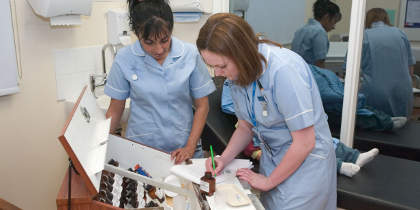
March 31, 2006, by Teaching at Nottingham
DysPEL: Dyslexia and Practice Environment Learning in Nursing
Fiona McCandless-Sugg, Jo Sanderson-Mann and Heather Wharrad:
Background and Overview
“Pre-registration Nursing Diploma courses require that 50% of student learning takes place in the classroom and the other 50% is achieved through practice experience in the clinical placement. There is little evidence about how dyslexia affects nurses and student nurses in workplace learning, and what educational institutions can do to help them. Disability legislation requires educational institutions to make “reasonable adjustments” for disabled students, enabling them to participate on an equal basis with other students. The legislation also applies to work placement settings; however there are currently few systems in place for supporting nursing students with dyslexia on clinical placement.
“The School of Nursing at the University of Nottingham covers a large geographical area. Theory based student learning is supported at six sites across Nottinghamshire, Derbyshire and Lincolnshire. Practice-based learning is supported by around 10,000 mentors at numerous clinical placements across the three counties. Between January 2004 and September 2005, a study was conducted in the School of Nursing to explore the workplace learning experiences of student nurses with dyslexia. The aim was to find out what difficulties they experienced and what the School could do to support the students, and their mentors, in practice learning. Ensuring that mentors are up-dated and able to meet their obligations under the legislation is important, and a related aim was to develop resources that could be utilised by mentors and students to increase their understanding and awareness of dyslexia.
Study
“A study was designed to explore the views of student nurses with dyslexia through group and individual interview. Nurse educators who support students on clinical placement were also interviewed. Questionnaires were developed to survey dyslexic and non-dyslexic student nurses about their experiences on clinical placement. The study was funded by various bodies: HEFEC Disability Allocation, School of Nursing, ESCalate and Making Practice Based Learning Work.
Student interviews
“Nine dyslexic student nurses were interviewed. They recounted positive and negative experiences on clinical placement and described difficulties they experienced with clinical placement tasks including handovers; documentation; carrying out observations and drug calculations and administration. Students had developed their own ways of dealing with tasks, and some had developed more strategies that others. Some tried to disguise dyslexia and attitudes towards disclosure varied. It was found that negative experiences on placement can affect subsequent decisions to disclose. Not all students wanted support, and some stated that they would like better understanding from nurse educators.
Nurse educator interviews
“Seven nurse educators were interviewed. Number of students mentored ranged from six to 100. There was some understanding of the issue of stigma around dyslexia, but only partial understanding of the dyslexic student?s perspective. Two had knowingly mentored a student nurse with dyslexia and two thought they may have, although the student did not disclose this to them. One dyslexic student?s placement was extended so that she could achieve her clinical competencies. A student who had difficulties with documentation and reading a drug chart failed her placement. Opinions about whether students should disclose varied, however most felt that it would be desirable to know.
Questionnaire results
“71 students with dyslexia and 71 non-dyslexic students were sent a questionnaire asking about their experiences on clinical placement. There was a 75% response rate. Students were asked to rate activities associated with clinical placement. The students with dyslexia reported more difficulty with using patient notes and care plans. Students were also asked to respond to statements about how they dealt with clinical placements in general, and there was a tendency for the dyslexic students to be less likely to ask someone for help if they did not understand something.
“With respect to disclosure of dyslexia, students were more likely to disclose to their mentors than to other members of staff. 50% never disclosed to other members of staff on their last placement, and 29.6% never disclosed to their mentor.
Conclusions
- The way dyslexia affects individuals varies enormously.
- Clinical placements are diverse, thus the challenges for student nurses with dyslexia will vary throughout their training.
- Problems that dyslexic students in this study experienced include difficulties with handovers, documentation, carrying out observations, drug calculations and administration. Using patient notes and care plans were also highlighted as areas that students with dyslexia also find problematic.
- Attitudes to disclosure vary.
- Mentors need more information and education about dyslexia.
- There is no one solution to the challenges that student nurses with dyslexia face in clinical practice; they are a heterogeneous group and their learning needs should be assessed and responded to on an individual basis.
A series of reusable learning objects is planned to raise awareness of dyslexia. The first one is available: Understanding Dyslexia: An Introduction
Dr Fiona McCandless-Sugg
Lecturer in Mental Health Nursing
School of Nursing, Midwifery & Physiotherapy
Jo Sanderson-Mann
School of Nursing, Midwifery & Physiotherapy
Prof Heather Wharrad
Professor of e-Learning and Health Informatics
School of Nursing, Midwifery & Physiotherapy
Notes:
- Since this study, Jo Sanderson-Mann has left the University to study for a PhD with the OU. Heather Wharrad is a member of the Centre for Excellence in Teaching and Learning (CETL) in Reusable Learning Objects.
- This is a study of the experiences of staff and dyslexic students in practice-based learning. More on the Thinking about Dyslexia website. Produced March 2006.
This article was originally published as part of PESL’s Teaching at Nottingham collection.
No comments yet, fill out a comment to be the first

Leave a Reply